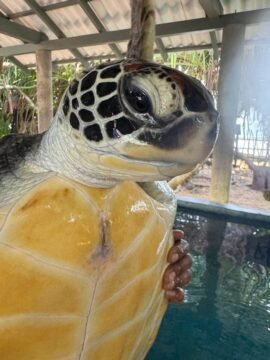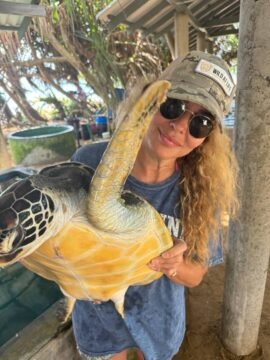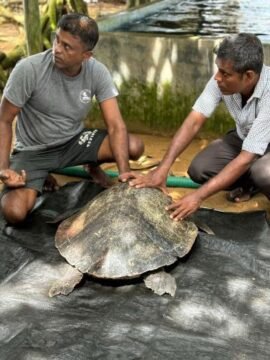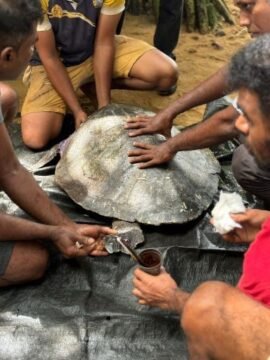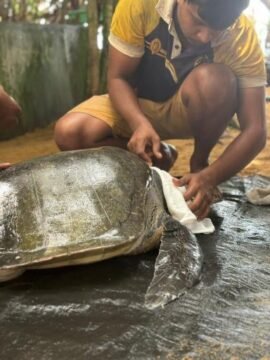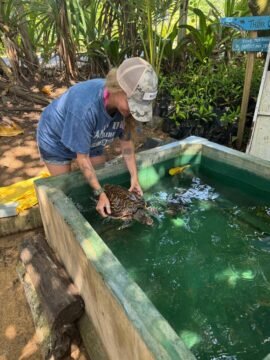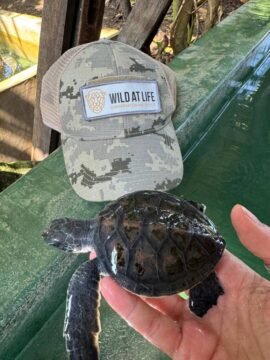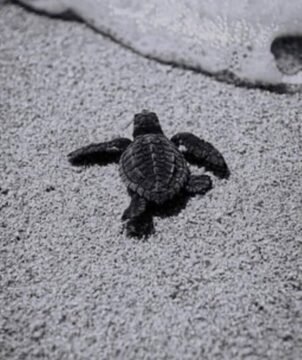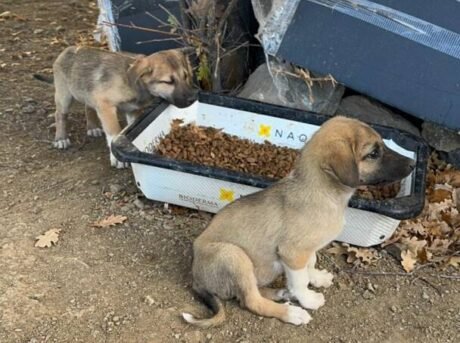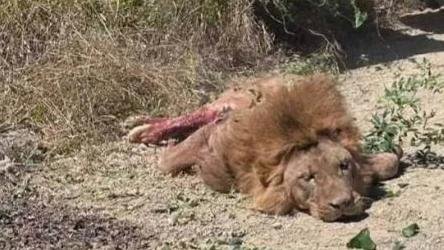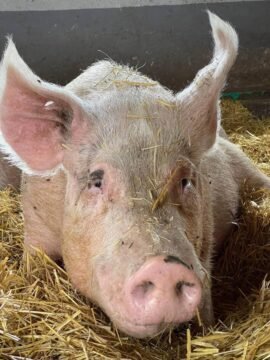Marine Turtles are a successful group of animals that have witnessed the rise and fall of the dinosaurs. They have inhabited the earth for over 100 million years and survived in huge numbers until the recent past. They have evolved from large, land-living tortoise-like animals. Their body consists of a head, a short neck, a pair of long fore-flippers & a pair of short and rounded hind flippers, and a tail. The upper carapace and lower plastron make a protective structure (box) for internal organs. Unlike tortoises and freshwater terrapins, sea turtles cannot withdraw their head and limbs into their box. Instead of teeth, sea turtles have beak-like sharp jaws that can crush, tear or bite their prey and food items which vary according to species.
Sea Turtle Mission
Implementation of sustainable conservation strategies to increase sea turtle populations in Sri Lanka and also in any countries we are needed.
Sea turtles are some of the most ancient and remarkable creatures in the ocean, yet they face numerous threats to their survival. From habitat destruction and climate change to pollution and illegal poaching, these majestic reptiles are struggling to survive in an increasingly hostile environment. As a result, many sea turtle species are now endangered or critically endangered. Our mission is to rescue and rehabilitate sea turtles in distress, working closely with local partners to ensure their survival and protection. In this article, we will explore the challenges faced by sea turtles, the actions being taken to conserve them, and how you can play a vital role in their preservation.
Most species are migratory, traveling long distances between nesting and feeding grounds, sometimes thousands of kilometers apart. Turtles are believed to live over 80 years, though their exact lifespan is uncertain. Sexual maturity varies by species—Olive Ridley turtles mature in 7-15 years, Green turtles take up to 50 years, while the largest species, the Leatherback, matures in 20-30 years. Male turtles develop long claws on each fore flipper and a longer tail upon reaching maturity. The way females find their nesting beaches remains a mystery, though some scientists believe they navigate using the Earth’s magnetic field. Turtles often return to the same stretch of beach each year to nest.
Seven species of marine turtles remain, representing two families—Cheloniidae and Dermochelyidae—all of which are threatened by human activity. Unlike some reptiles, mother turtles do not care for their young. After laying eggs, they leave them to incubate in the sand, heated by the sun. The incubation period lasts about 60 days, after which the hatchlings emerge. As they move in the nest, sand falls, creating an “elevator-like” platform that pushes the hatchlings to the surface. They emerge at night when it’s cooler and safer from predators like rats, crabs, and birds.
Upon reaching the ocean, the hatchlings are not free from danger. Inshore waters are home to sharks, large fish, and seabirds. They swim continuously for about 48 hours, relying on the remains of the egg yolk in their stomachs for nourishment. This “juvenile frenzy” helps them escape predator-rich inshore waters and get swept into open ocean currents. During this time, they feed on tiny sea animals. Much about their first year, often called the “lost year,” remains a mystery.
It is believed that once female turtles reach maturity, they return to the same beach where they hatched to nest. However, only one in a thousand eggs survives to become an adult turtle in the wild.
Our Mission

Our goal is to rescue distressed sea turtles and provide them with the care they need through our rehabilitation program, in collaboration with local organizations. We carefully assess each turtle’s condition, provide necessary medical treatment, and create a safe environment for their recovery. Once they are fully healed, we work towards releasing them back into the wild. This partnership is essential to ensuring the survival and well-being of sea turtles in our region, helping them return to their natural habitat and thrive.
How Endangered Are Sea Turtles?

There are seven species of sea turtles, each facing varying levels of threat. According to the IUCN Red List, two are critically endangered, one is endangered, three are vulnerable, and one is data deficient:
Kemp’s Ridley Turtle – Critically Endangered
Hawksbill Turtle – Critically Endangered
Green Turtle – Endangered
Olive Ridley Turtle – Vulnerable
Leatherback Turtle – Vulnerable
Loggerhead Turtle – Vulnerable
Flatback Turtle – Data Deficient
What Threats Are Sea Turtles Facing?
Sea turtles face several significant threats that impact their survival, including:
Habitat Destruction caused by coastal development, including construction, leads to the destruction of critical nesting beaches. Erosion, along with the loss of coral reefs and seagrass beds, further contributes to the loss of vital habitats for sea turtles.
Climate Change poses major risks through rising temperatures, sea levels, and ocean acidification. Higher sand temperatures at nesting sites can alter the sex ratios of hatchlings, as turtle sex is temperature-dependent during incubation. Additionally, climate change disrupts ocean currents, affecting sea turtle migration patterns and food availability.
Pollution, particularly plastic debris, severely threatens sea turtles. Ingesting plastic, often mistaken for food, can lead to internal injuries or death. Chemical pollutants, such as oil spills and pesticides, contaminate both their habitat and food sources.
Bycatch is another significant threat, as sea turtles are unintentionally caught in fishing gear like nets, longlines, and trawls. Bycatch can result in severe injuries or death due to drowning, as turtles must surface for air.
Illegal Trade and Poaching continue to threaten sea turtles, with their meat, shells, and eggs harvested for use in traditional medicine and as delicacies.
Light Pollution on beaches can disorient hatchlings, leading them away from the sea and into danger. Light pollution also discourages females from nesting, negatively impacting reproduction rates.
Predation of eggs and hatchlings by birds, crabs, raccoons, and dogs further endangers sea turtle populations, especially in their early stages of life.
Boat Strikes are a severe threat, as collisions with boats and ships often result in severe injuries or death, particularly in areas with heavy boat traffic.
Our Rescue and Rehabilitation Efforts
We are dedicated to rescuing sea turtles that have been harmed by human activity, including boat strikes, plastic pollution, and fishing-related injuries. Many of the turtles we rescue have lost their fins due to boat collisions, leaving them vulnerable. We provide a safe space for them to recover and ensure they can hatch their eggs without the risk of destruction on land.
For the wounded turtles, we take them into our care, treat their injuries, and, whenever possible, release them back into the wild. However, those that are too injured to be released are given a permanent home in our sanctuary, where they are cared for and protected.
How Can I Help Sea Turtles?
You can help protect sea turtles by preserving their habitats, reducing plastic use, and properly recycling to prevent pollution. Advocate for turtle-friendly legislation, respect nesting areas, and raise awareness about the importance of turtle conservation. You can also adopt a turtle through conservation programs, volunteer to patrol nesting beaches, collect eggs, record data, release hatchlings, and educate local communities
No results found.
Spread the news!
Help us increasing social commitment in saving endangered wild species. Express your support by sharing this article in your favorite social media channel.
Most recent news
Sea turtles are among the most ancient and extraordinary creatures in our oceans, but today they are facing more threats than ever before. Climate change, habitat destruction, pollution, irresponsible fishing practices, and illegal poaching have all pushed many species to
Every day, our team works tirelessly to care for the hundreds of stray animals living on the outskirts of Ankara. We currently feed between 250–300 dogs daily, ensuring that no one goes hungry — even in the most remote and
A male lion named Zeus escaped from the underground animal park Aslan Diyarı in Antalya’s Manavgat district, attacking and injuring a local farmer, Süleyman Kır, before being captured and killed. Zeus had broken free from his cage at a private
The last World Lion Day was not a celebration for us. Instead of sharing uplifting stories, we had to deliver heartbreaking news: the matriarch of the Hippo Creek Pride in Victoria Falls was brutally killed by poachers. She was an
Wild at Life e.V. cares for dozens of rescued farm animals — especially pigs — who now live safely with our partner NGO, an organization that provides a home to hundreds of farm animals. Among them are many pigs we
Verängstigt und verstört drängen sich die Affen an die Gitterstäbe ihrer viel zu kleinen Käfige –Bilder, die einem die Tränen in die Augen treiben. Doch für Tierschützerin Aslihan Gedik sind sie kein seltener Anblick. Immer wieder müssen sie und ihr
Subscribe to our newsletter to keep up to date with our activities!

